If you ask me, sourdough discard recipes are a game-changer.
This crusty French bread puts your leftover sourdough starter to good use, giving you a loaf that’s both practical and tasty. The tang from the discard adds a nice depth that you just don’t get with regular French bread.
It’s made with basic pantry ingredients and comes together with just a bit of patience – most of the time is hands-off while the dough does its thing. The result is a golden-brown loaf with a crisp outside and soft inside.
It’s a home baker’s friend that makes your kitchen smell amazing and gives you that satisfaction of making bread from scratch.
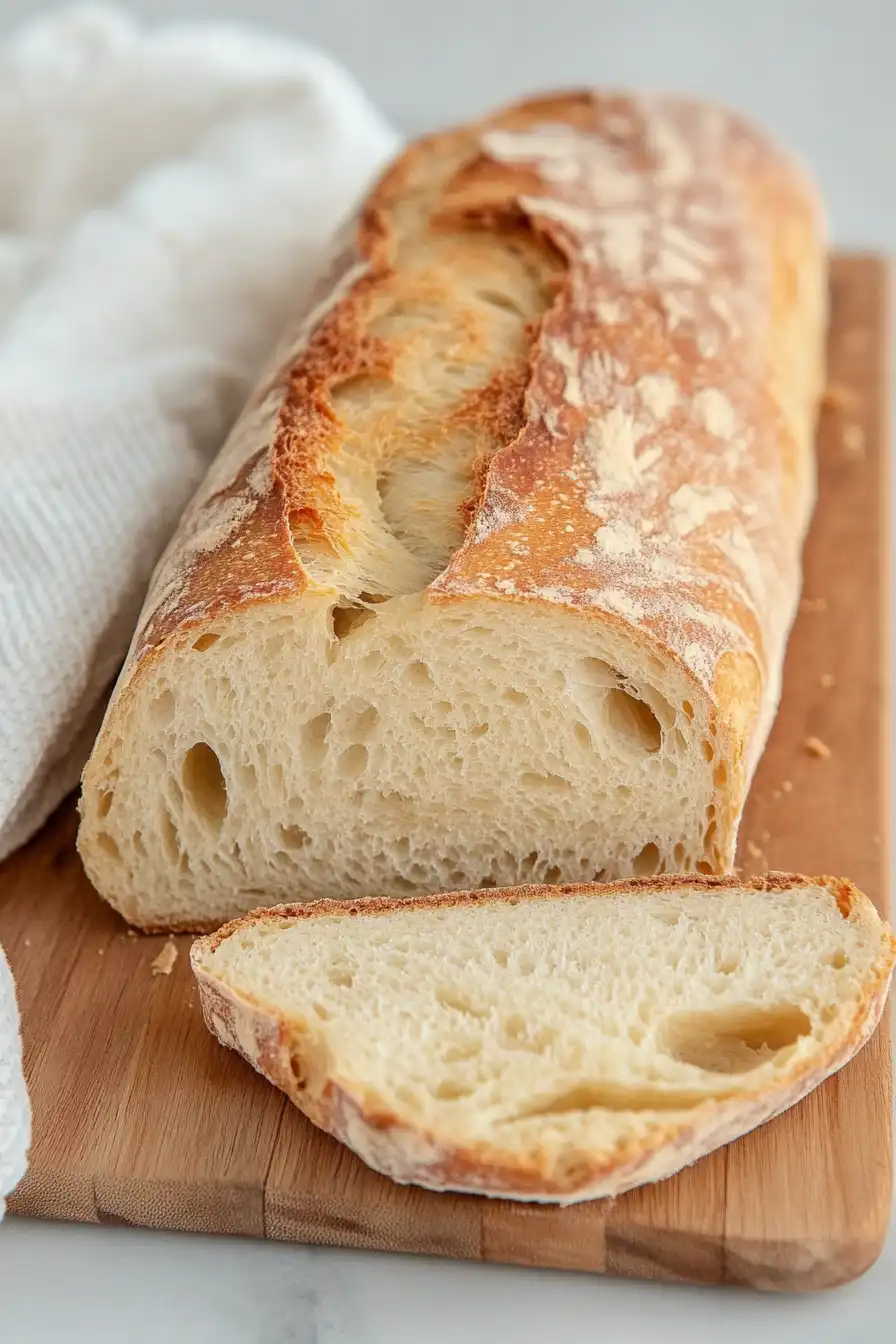
Why You’ll Love This French Bread
- Zero waste baking – This recipe helps you use up that extra sourdough discard that usually goes to waste, making it both eco-friendly and practical for regular sourdough bakers.
- Quick preparation – Unlike traditional sourdough bread that takes days to make, this French bread comes together in just about 90 minutes thanks to the addition of instant yeast.
- Reliable results – The combination of sourdough discard and instant yeast gives you the best of both worlds – complex flavor and guaranteed rise every time.
- Simple ingredients – You only need basic pantry staples plus your sourdough discard to make this bread, and the measurements are provided in both weight and volume for convenience.

What Kind of Sourdough Discard Should I Use?
Your sourdough discard can be fresh from a recent feeding or stored in the fridge for up to a week – both will work great in this recipe.
The discard should be at 100% hydration, which means you’ve been feeding it with equal parts flour and water by weight.
If your discard is a bit older and has some liquid on top (often called “hooch”), just stir it back in before measuring.
Don’t worry too much about whether your discard is at peak activity since we’re adding commercial yeast to do the heavy lifting in this recipe.
Just make sure your discard isn’t showing any signs of mold or giving off an unpleasant smell.
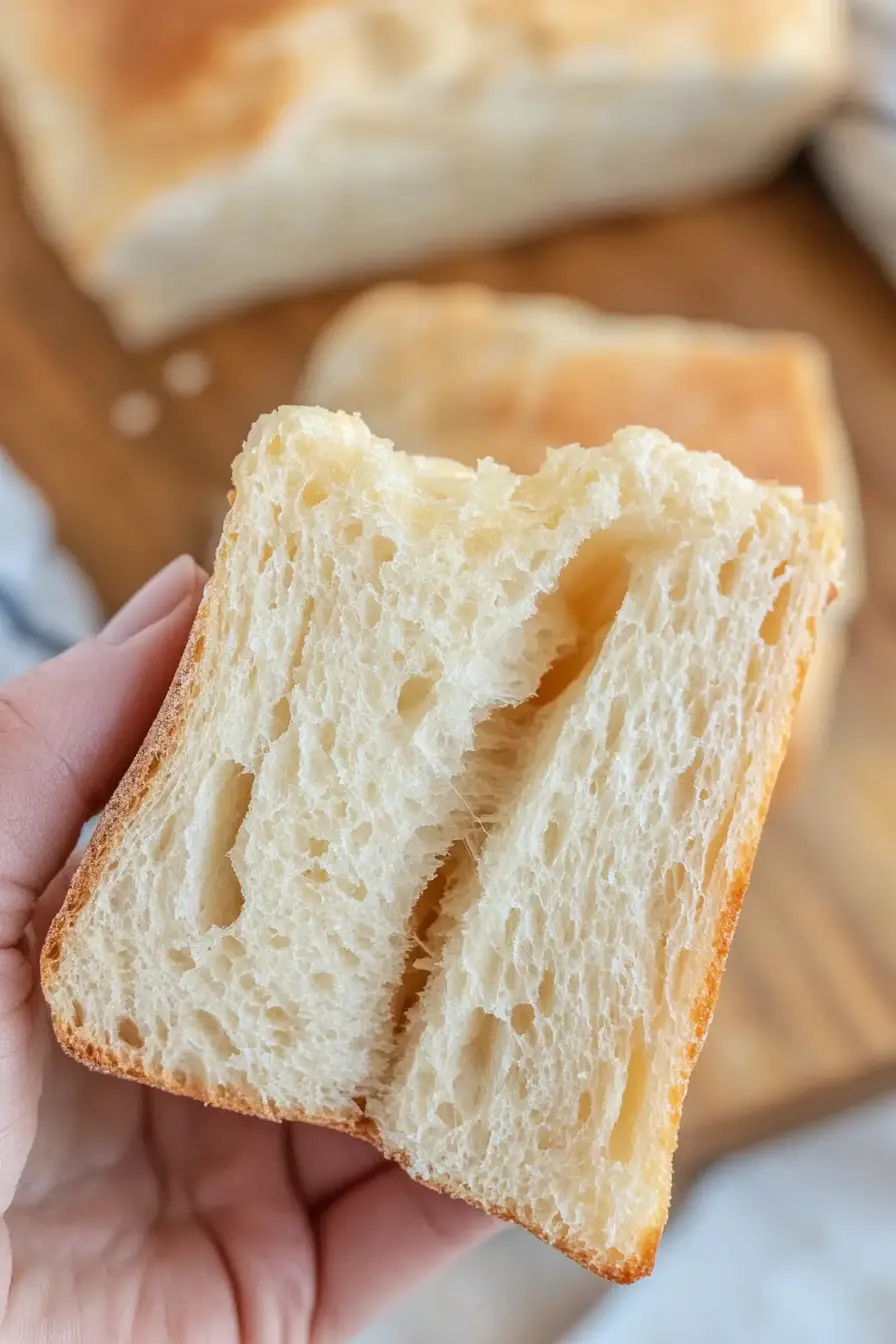
Options for Substitutions
Let’s talk about what you can swap in this recipe while still getting that perfect French bread:
- Sourdough discard: If you don’t have sourdough discard, you can replace it with equal parts flour and water (100g each), but you’ll miss out on that nice tangy flavor. The discard adds both flavor and texture, so this substitution will change the final taste.
- Bread flour: While bread flour is really best for this recipe due to its higher protein content, you can use all-purpose flour in a pinch. Just know your bread might be slightly less chewy and won’t rise quite as high.
- Honey: You can swap honey with regular sugar, maple syrup, or even agave nectar. Each will work fine to feed the yeast, though they might add subtle flavor differences.
- Coconut oil: Any neutral oil works great here – try vegetable oil, canola oil, or even light olive oil. Just avoid oils with strong flavors that might compete with the bread’s taste.
- Instant yeast: If you only have active dry yeast, use the same amount but dissolve it in the warm water first and wait 5-10 minutes until it gets foamy before adding to the mix.
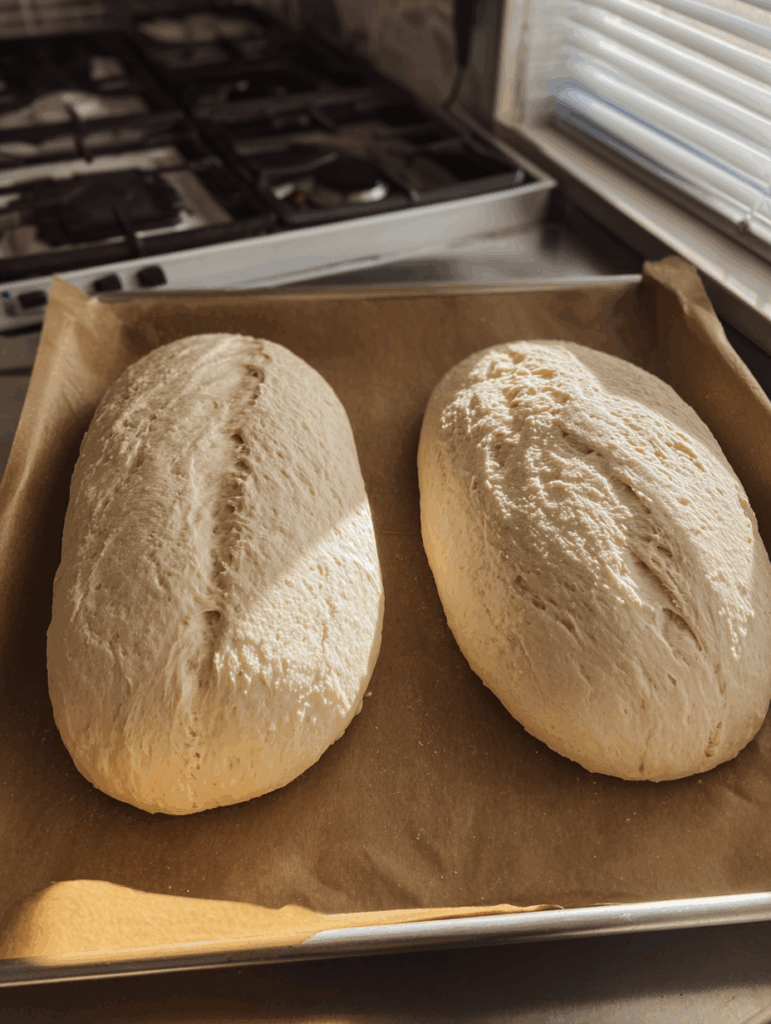
Watch Out for These Mistakes While Baking
The biggest challenge when making sourdough discard french bread is incorrect water temperature – using water that’s too hot will kill the yeast, while too cold will slow down fermentation, so aim for water that feels warm but not hot to the touch (around 95-100°F).
Another common mistake is not giving the dough enough time for proper gluten development – make sure to knead until you can stretch a small piece of dough thin enough to see light through it (the window pane test).
The scoring depth can make or break your loaf – cutting too shallow won’t allow proper expansion, while too deep can deflate the bread, so aim for about 1/4 inch deep cuts at a 45-degree angle.
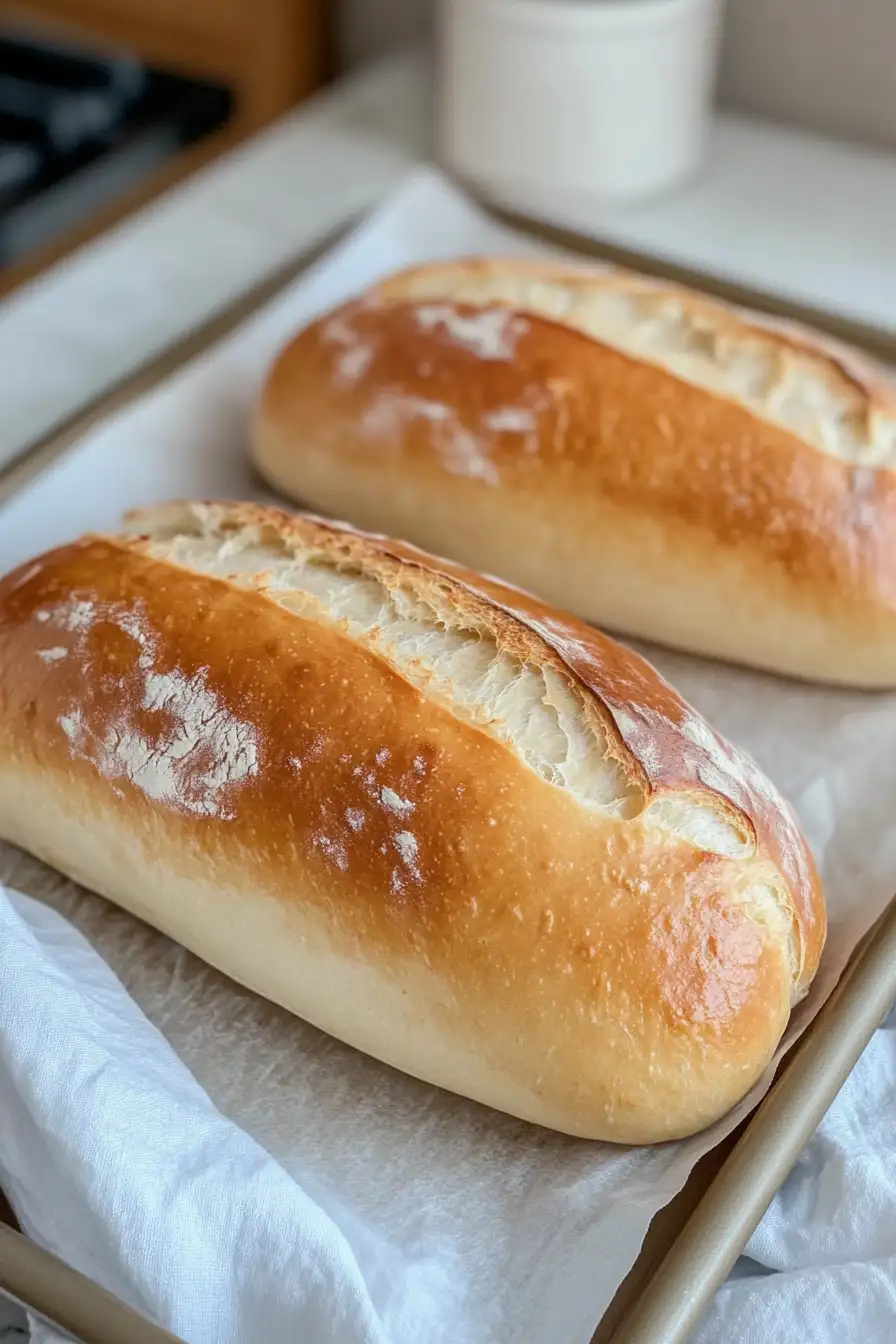
What to Serve With French Bread?
Fresh homemade French bread is perfect for creating a simple but satisfying meal spread!
I love serving it while it’s still slightly warm with good quality salted butter and a selection of cheeses – anything from brie to sharp cheddar works great.
For a casual dinner, try using it to make hearty sandwiches filled with cold cuts, or tear off chunks to dip in olive oil and balsamic vinegar.
You can also serve it alongside pasta dishes or soups to soak up all those tasty sauces and broths – it’s especially good with a bowl of classic French onion soup or homemade marinara.

Storage Instructions
Keep Fresh: Your homemade French bread will stay fresh at room temperature for about 2-3 days when wrapped in a clean kitchen towel or paper bag. The crust might soften a bit, but that’s totally normal. For the best taste and texture, try to enjoy it within the first day or two after baking.
Freeze: This bread freezes really well! Let it cool completely, then slice it (or leave whole), wrap it tightly in plastic wrap and pop it in a freezer bag. It’ll keep for up to 3 months in the freezer. I like to slice mine before freezing so I can grab just what I need.
Revive: To bring back that fresh-baked taste, sprinkle the bread with a little water and pop it in a 350°F oven for about 5-10 minutes. If using frozen bread, let it thaw at room temperature first. You can also toast individual slices straight from frozen – they’ll just need an extra minute or two in the toaster.

| Preparation Time | 20-30 minutes |
| Cooking Time | 30-35 minutes |
| Total Time | 80-95 minutes |
| Level of Difficulty | Medium |
Estimated Nutrition
Estimated nutrition for the whole recipe (without optional ingredients):
- Calories: 3200-3500
- Protein: 80-100 g
- Fat: 120-140 g
- Carbohydrates: 600-650 g
Ingredients
- 200 grams sourdough discard (hydrated at 100%, roughly 3/4 cup)
- 430 grams warm water (approximately 1 3/4 cups)
- 40 grams honey (around 2 tablespoons)
- 10 grams instant yeast (near 1 tablespoon)
- 70 grams coconut oil (or other neutral oil, roughly 1/3 cup)
- 20 grams salt (about 1 tablespoon)
- 860 grams bread flour (close to 6 cups)
Step 1: Prepare the Sourdough Mixture
- 200 grams sourdough discard (hydrated at 100%, roughly 3/4 cup)
- 430 grams warm water (approximately 1 3/4 cups)
- 40 grams honey (around 2 tablespoons)
- 10 grams instant yeast (near 1 tablespoon)
In the bowl of a stand mixer, combine your sourdough discard and warm water.
If the discard is cold from the refrigerator, ensure the water is very warm or even hot.
Mix together using a spoon or your hands to evenly distribute the temperature and avoid killing the yeast when you add it.
Add the instant yeast and honey, then let it sit until it becomes foamy and smells yeasty, indicating the yeast is active.
Step 2: Form the Dough
- 70 grams coconut oil (or other neutral oil, roughly 1/3 cup)
- 20 grams salt (about 1 tablespoon)
- 860 grams bread flour (close to 6 cups)
Add the oil, salt, and bread flour to the bowl.
Attach the dough hook to your stand mixer and knead the dough for about 8 minutes until it becomes smooth and elastic.
The dough should feel tacky but not overly sticky; if it is too sticky, gradually add a little more flour while continuing to knead.
Alternatively, knead by hand for 10-12 minutes until the desired consistency is achieved.
Step 3: Let the Dough Rise
Transfer the kneaded dough to a dough container.
Allow it to rise for approximately an hour, or until it doubles or triples in size.
The exact time will depend on the dough’s temperature.
To expedite the rising process, place the dough in a warm environment or use a dough mat.
Step 4: Shape the Dough
Turn the risen dough out onto your work surface and divide it into two equal portions.
Using your fingers, press each portion into a rectangle shape, slightly shorter than your baking sheet.
Roll each rectangle up while pinching in the seams as you go, then pinch the ends closed.
Place each rolled loaf on one half of a parchment-lined baking sheet.
Step 5: Second Rise and Preheat the Oven
Cover the shaped loaves with a kitchen towel and allow them to rise again for one to two hours, depending on the dough’s temperature, until they double in size and appear puffy, light, and airy.
Meanwhile, preheat the oven to 375°F.
Step 6: Score and Bake
With a bread lame or sharp knife, score the loaves by making several slashes across the top, or opt for a single large slash down the middle.
Bake the loaves in the preheated oven for 30-35 minutes until they turn golden brown.
Once baked, brush the warm loaves with melted butter.
Allow them to cool slightly before slicing and serving.
Enjoy your homemade bread!
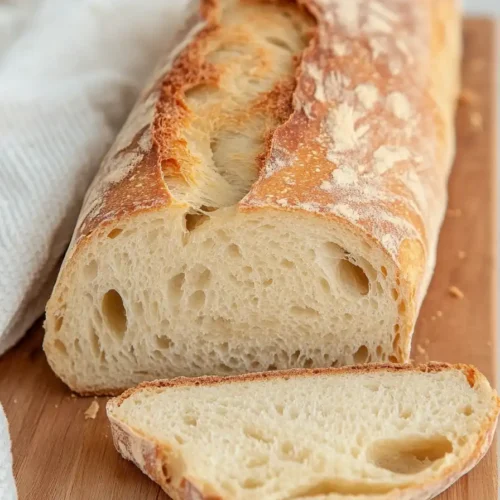
Perfect Sourdough Discard French Bread
Ingredients
- 200 grams sourdough discard (hydrated at 100%, roughly 3/4 cup)
- 430 grams warm water (approximately 1 3/4 cups)
- 40 grams honey (around 2 tablespoons)
- 10 grams instant yeast (near 1 tablespoon)
- 70 grams coconut oil (or other neutral oil, roughly 1/3 cup)
- 20 grams salt (about 1 tablespoon)
- 860 grams bread flour (close to 6 cups)
Instructions
- In the bowl of a stand mixer, combine your sourdough discard and warm water. If the discard is cold from the refrigerator, ensure the water is very warm or even hot. Mix together using a spoon or your hands to evenly distribute the temperature and avoid killing the yeast when you add it. Add the instant yeast and honey, then let it sit until it becomes foamy and smells yeasty, indicating the yeast is active.
- Add the oil, salt, and bread flour to the bowl. Attach the dough hook to your stand mixer and knead the dough for about 8 minutes until it becomes smooth and elastic. The dough should feel tacky but not overly sticky; if it is too sticky, gradually add a little more flour while continuing to knead. Alternatively, knead by hand for 10-12 minutes until the desired consistency is achieved.
- Transfer the kneaded dough to a dough container. Allow it to rise for approximately an hour, or until it doubles or triples in size. The exact time will depend on the dough’s temperature. To expedite the rising process, place the dough in a warm environment or use a dough mat.
- Turn the risen dough out onto your work surface and divide it into two equal portions. Using your fingers, press each portion into a rectangle shape, slightly shorter than your baking sheet. Roll each rectangle up while pinching in the seams as you go, then pinch the ends closed. Place each rolled loaf on one half of a parchment-lined baking sheet.
- Cover the shaped loaves with a kitchen towel and allow them to rise again for one to two hours, depending on the dough’s temperature, until they double in size and appear puffy, light, and airy. Meanwhile, preheat the oven to 375°F.
- With a bread lame or sharp knife, score the loaves by making several slashes across the top, or opt for a single large slash down the middle. Bake the loaves in the preheated oven for 30-35 minutes until they turn golden brown. Once baked, brush the warm loaves with melted butter. Allow them to cool slightly before slicing and serving. Enjoy your homemade bread!


This sounds delicious! I want to try making it. But curious as to why so much salt? I am new to the sourdough cooking. Thank you.
Easy and so delicious! I baked the loaves in the evening to have them ready for breakfast. When I got in the kitchen the next morning half of one loaf was already gone. My son just couldn’t wait and couldn’t get enough of it. Thank you for sharing!
This bread is delicious and my first attempt at anything other than sourdough. turned out excellent even if I didn’t do everything right (due to inexperience). Thank you